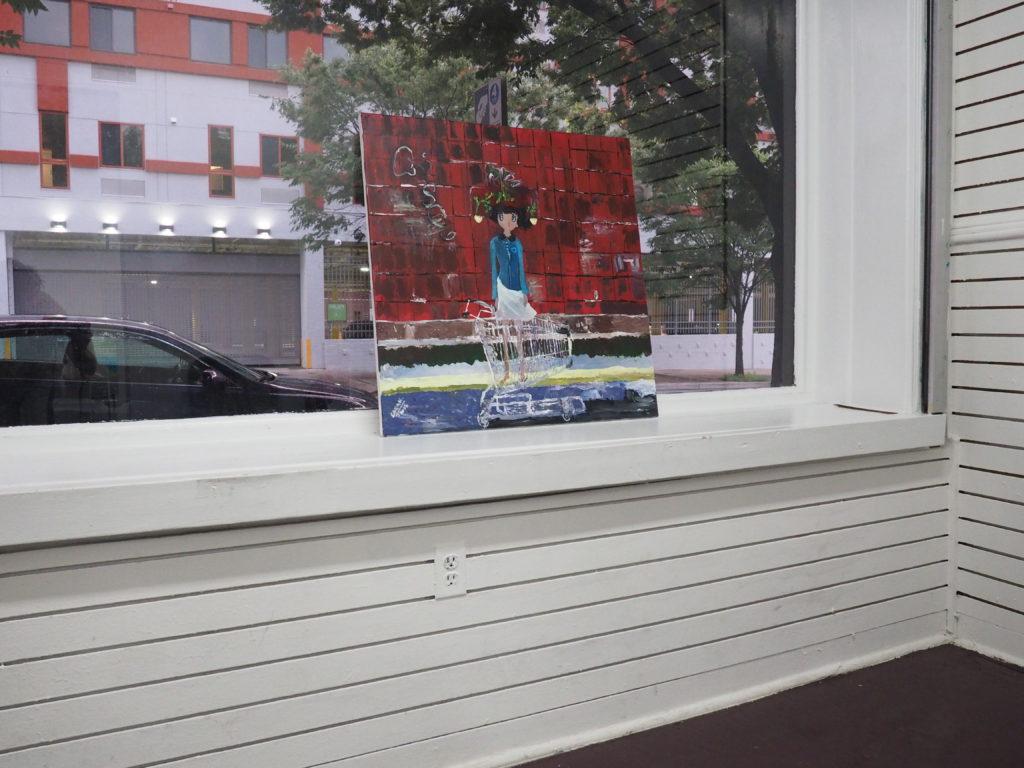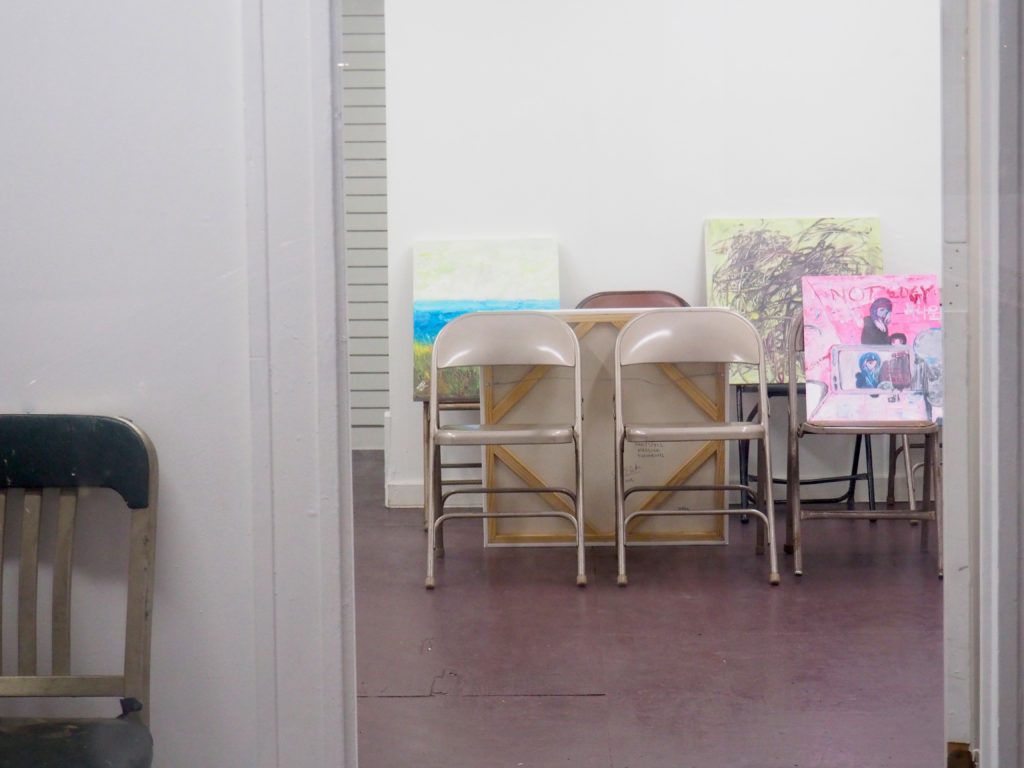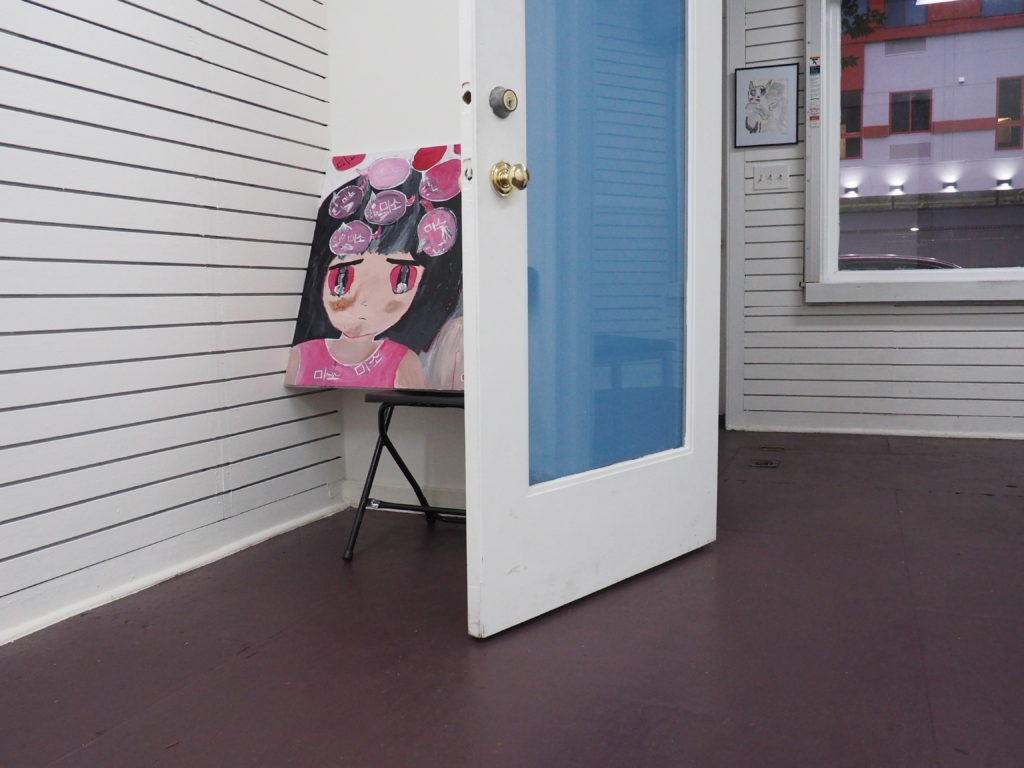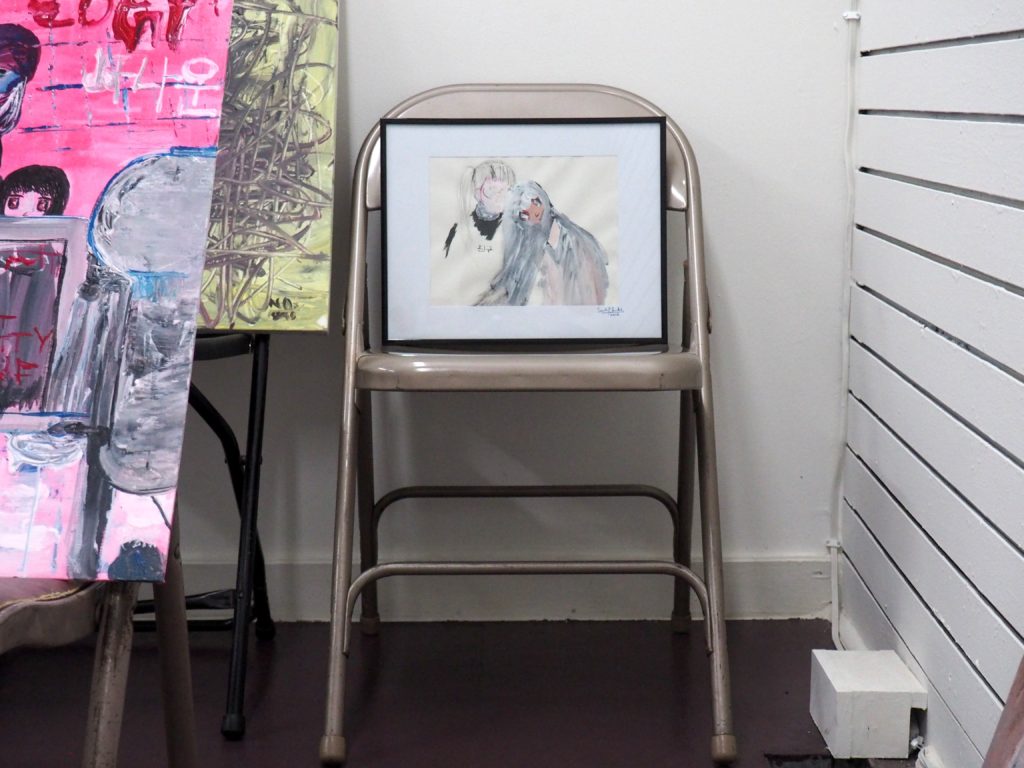
The Group Show features new paintings by Sarah Hai Edwards operating under the guise of three personas, each of which maintains independent studio practices. The work is displayed mostly on the floor and other surfaces of Rope, leaned against an arrangement of chairs with varying amounts of room for viewing. The arrangement is casual and awkward, and I imagine a Free School setting up for a workshop with a similar level of care.
Edwards’ personas cover three semi-distinct fields of work: Nooks Sez operates in the language of traditionalist abstract-expressionist mark making, Sarah Edwards works in a casual “Sunday painter” observational landscape style, and Sarah Hai mainly works in anime-style cartooning. This information was received verbally in a friendly setting — at the opening, the gallery directors maintained a continuous conversation over casual air, according to co-director Seán Boylan, “speaking about the show and Edwards’ work to people who attended and wanted to engage in discussion.” According to Boylan, the gallery originally received submission from one of Edwards’ personas, and later discovered another persona independently. After connecting all three projects, the directors proposed the opportunity of showing each body of work together in one show.
It’s a strange and exciting arrangement of work, but there are two aspects to this show that I want to address specifically because of those aspects’ failure to reconcile with each other: the show’s efforts as an exhibition of deskilled painting and the show’s efforts to showcase a conceptual curatorial project.
In the former, the topic of deskilled art practice has been worked to death. When reading about the aspect of Manet and Courbet being “castigated for what was taken to be their formal inchoateness, and lack of technique or facilite,” there’s a haunted aura in the air; we can point to where these histories take us, who is remembered, etc. 1 The topic in contemporary art 1970—> has primarily covered post-studio, hands-off, and appropriation based practices, but more recently has returned to the topic of casual-handedness.
I mention this because the paintings are bad and are similar to work I see produced in high school art programs: frantic, ambitious, direct, angsty. Deskilled in every sense, though not so much in the way I identify other hands-on provisionalist, folk, or outsider practices, where value might be found in material integrity, rawness of form, discipline of labor/conviction, or innovative use of obvious/accessible materials. Studio work that might be considered more elegantly handled in comparison brings to mind Judith Bernstein, Trevor Shimizu, Basquiat, Quintessa Matranga [who has contributed to this journal], and Rafael Delacruz — explicitly non-virtuosic line work but, rather, hard-headed practices that manage to evoke a sense of resolution.
 Historically, a push towards deskilling (and valuing the deskilled) came paired with political implications, as it pushed the artist’s identification with the laborer by demoting the artist’s perceived agency and by including the laborer in the artist’s methods. 2 This is worth noting at a time when the field seems to have twisted that ideal of deskilling by developing a combination of hands-off deskilled practice, outsourced (skilled) labor, and, somehow, the promoted agency of the artist. In the field of practices in the above mentioned artists, both canonized and contemporary work might find potency in the development of the non-professionalized object, something that seems integral at time when deskilling seems to have lost much of its embedded politics. I do, however, want to acknowledge that those mentioned hard-headed practices appear to contain complexities within them that are absent in Sarah Edwards’ practice. The line between deskilled practice and amateur practice is almost too blurry to mention, but it seems to play a role here.
Historically, a push towards deskilling (and valuing the deskilled) came paired with political implications, as it pushed the artist’s identification with the laborer by demoting the artist’s perceived agency and by including the laborer in the artist’s methods. 2 This is worth noting at a time when the field seems to have twisted that ideal of deskilling by developing a combination of hands-off deskilled practice, outsourced (skilled) labor, and, somehow, the promoted agency of the artist. In the field of practices in the above mentioned artists, both canonized and contemporary work might find potency in the development of the non-professionalized object, something that seems integral at time when deskilling seems to have lost much of its embedded politics. I do, however, want to acknowledge that those mentioned hard-headed practices appear to contain complexities within them that are absent in Sarah Edwards’ practice. The line between deskilled practice and amateur practice is almost too blurry to mention, but it seems to play a role here.
The impulse to make medium-specific pieces with heavy hand and clumsy representation is at odds with the solutions some post-studio or post-net practices settle on: the hands-off fabrication of fetishized value object. 3 This method seems to be employed, at times, in order to subsidize a more complex, immaterial practice. At other times, it appears to be for the sake of trend research and accumulating various forms of capital. And while a hands-on deskilling impulse might combat issues that arise in both of those production schemes, it could reveal something else entirely: who is able to leverage a half-assed practice into gallery space, critical coverage, and audience? Perhaps the practice becomes the hustle and the social circle in that scenario. I’m reminded of one myth for the name origins of “Dada:” a simple Romanian translation from “yes, yes.” That would be reciprocal positive feedback loops within an avant garde social circle, but I’m curious: who is saying “yes, yes,” now? This brings us back to that question of deskilled vs. amateur practice: deskilled artists have agency to select context, while amateur artists have to rely on the grace of curatorial interest.
The quality of work in these paintings is an important starting point before discussing the curatorial aspect simply because of its nature as a foundation to the show. Within the curation, the audience is presented a group show between three constructed personas that each umbrella a separate body of work. This functions so that the audience is presented with a balance between bad, sincere painting and a conceptual curatorial project about split identities. The solution of displaying work and chairs in the gallery feels satisfying, but the agendas conflict, each operating at odds with the other in a way that denies coexistence.

Placing the malleability of identity at the forefront of a practice has a long history — Duchamp as Rrose Selavy, Stephen Kaltenbach as Clyde Dillon, Adrian Piper as Mythic Being, Amalia Ulman as Amalia Ulman — and I can’t overstate the important potential of this tactic in understanding “self” as the contemporary subject and its conditions shift. Here, however, it feels forced and partially flattened through the immediate display of such personas as pinned down butterflies to observe. The curators place the burden of that content onto an artist who is, possibly, using personas as trial and error to unearth a practice she can believe in. That weight hedges the bets placed on both ideas; the paintings feel like placeholders for ideas, and the curation feels like an afterthought.
This may partially be due to the utilitarian function of the split identity and the relationship between the curators and those personas (or selves?) being displayed as “art objects.” In Boris Groys’ “Curator as Iconoclast,” he describes the historical relationship between curators and religious artifacts in early museums at the turn of the 19th century, “All kinds of ‘beautiful’ functional objects, which had previously been employed for various religious rituals, dressing the rooms of power, or manifesting private wealth were collected and put on display as works of art—that is, as defunctionalized, autonomous objects of pure contemplation. The curators administering these museums ‘created’ art through iconoclastic acts directed against traditional icons of religion or power, by reducing these icons to mere artworks. Art was originally ‘just’ art.” 4
Groys goes on to claim that the difference between the artist and the curator is that the artist doesn’t devalue sacred objects as the curator might, but rather promotes mass-produced objects. “Sacred objects were once devalued [by curators] to produce art; today, in contrast, profane objects are valorized [by artists] to become art.” 5

How do Edwards’ split personas operate within this proposal? Are the practices reflecting “self” or “persona” here? As identities, those two facets might function with a relationship similar to the one shared between religious objects and profane, manufactured objects as Groys describes, where religious/functional objects (that is, utilitarian and iconographic instances of communion and ornamentation) are defunctionalized for contemplation, demoted to “just art” by curators, and profane objects (that is, non-spiritual, manufactured commodities) are promoted to the level of “Art” by artists. By presenting the personas as identity brands, the curators might be promoting the profane to the level of “Art” and, in turn, playing the role of the artist. On the other hand, if the personas act for Edwards as personal tools for self-realization (or, operating in religious terms, “communion” with self), the curators perform the iconoclastic act of demoting the once-charged object. There is conflict in both scenarios.
A malleable/split identity practice holds water, perhaps paradoxically, when it is still functioning and maintaining ambiguity. By placing the works into a single show that relies on “the reveal,” the project is flattened just in time for the audience to see it. Because of this situation, the question of whether or not the paintings are “good” seems besides the point; they could operate within a history of avant-garde deskilling or within a history of “selected” amateur work, and are placed in a situation where they can’t fully vie for either position.
Edited: March 18, 2018